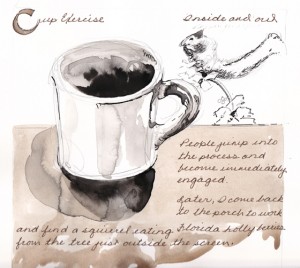Design Safari
My safari took place in my small Florida island village that has a population of 588 registered voters. Most of the population lives a simple life: fishermen, crabbers, and people who farm clams. There is a small group of retired people, artists, and writers.
As I studied the Design References this week and reflected on my own work of many years as an artist and illustrator, it occurred to me that the principles of good design are both objective and subjective. The objective interpretation is universal and may be relatively fixed. However, these objective standards are constantly subject to different interpretations of design based on the influences of intention, culture, time, age, nationality, and history, In other words, design keeps changing. The differing interpretations of good design are the subjective interpretations, and these subjective interpretations make it difficult to categorize the subject of design into a set number of “basic design principles.” Thus, there may be 10 principles, 12 principles, 7 principles, etc., and some information is in constant flux and may be quite confusing. This week, as I moved around my home and my home town and I looked for and found several images that illustrate different aspects of design – elements that I consider to be most important, or at the very least, the most obvious.
We, as human beings, tend to mentally organize our surroundings through our ways of seeing and interpreting what we see. If we are artists (and I believe that we all are artists!), we create our environments in ways that reflect how we organize or DESIGN. I believe that design comes from our early upbringing, our education, and the cultural differences to which we are exposed. For me, I have studied and traveled and I bring these experiences to my own design repertoire.
Symbolism: Form and its Function (Gestalt)
 This first principle indicates that the organization is around symbols. This principal also presupposes how these symbols relate to their surroundings. A well-designed symbol can also manipulate people’s minds by influencing their intuition and emotion. Here, a simple sign warns drivers on a remote street that they must turn either to the right or to the left to avoid driving into the water. This sign is in my town and the water is the Gulf of Mexico! The intellectual element of design here is irony because the sign seems so obvious during the beautiful day; however, at night, with little ambient light, an impaired driver might find this sign necessary as a life-saving design element.
This first principle indicates that the organization is around symbols. This principal also presupposes how these symbols relate to their surroundings. A well-designed symbol can also manipulate people’s minds by influencing their intuition and emotion. Here, a simple sign warns drivers on a remote street that they must turn either to the right or to the left to avoid driving into the water. This sign is in my town and the water is the Gulf of Mexico! The intellectual element of design here is irony because the sign seems so obvious during the beautiful day; however, at night, with little ambient light, an impaired driver might find this sign necessary as a life-saving design element.
Balance
 Balance in design can be achieved by several strategies when composing different media. When I consider balance, I think of the rules of algebra, where one side of the equal sign must balance the other side – like a see-saw. The problem in design, however, is that the elements are very different – images, type, sound, motion, time, etc. I collected this simple and random example from my collection of illustrated journals, called Journey Daybooks. I made this page last summer in New Orleans. Here there is a simple painted image of a crawfish (figure) and the page shows lots of white (ground.) There is writing (notes and lists) scattered around the white ground that serve to stop the eye a bit as it scans the page. This page seems balanced to me because of the large amount of ground and the placement and importance of the bright, orange figure. When I make such pages, I tend to leave a lot of white ground. This is a personal preference and seems important to “my eye!”
Balance in design can be achieved by several strategies when composing different media. When I consider balance, I think of the rules of algebra, where one side of the equal sign must balance the other side – like a see-saw. The problem in design, however, is that the elements are very different – images, type, sound, motion, time, etc. I collected this simple and random example from my collection of illustrated journals, called Journey Daybooks. I made this page last summer in New Orleans. Here there is a simple painted image of a crawfish (figure) and the page shows lots of white (ground.) There is writing (notes and lists) scattered around the white ground that serve to stop the eye a bit as it scans the page. This page seems balanced to me because of the large amount of ground and the placement and importance of the bright, orange figure. When I make such pages, I tend to leave a lot of white ground. This is a personal preference and seems important to “my eye!”
Rhythm
 The sabal, or cabbage palm grows wild and is prolific here. In fact, it is the Florida state tree – probably for this reason. It shows an incredible rhythm and order in the way the palm fronds grow off the main stalk, especially in young cabbage palms. As an aside, the palm is a monocot, related to grass, bamboo, and orchids! These plants are hearty and also fascinating to study. The very obvious growth pattern of the sabal palm, obvious when the fronds are cut or fall off, also demonstrates a unity of design that it often seen in the natural world. Shells show this same unity of design. The chambered nautilus illustrates the “golden mean,” – a mathematically “perfect” design that was first described by man in classical times. Nature can be perfect in design!
The sabal, or cabbage palm grows wild and is prolific here. In fact, it is the Florida state tree – probably for this reason. It shows an incredible rhythm and order in the way the palm fronds grow off the main stalk, especially in young cabbage palms. As an aside, the palm is a monocot, related to grass, bamboo, and orchids! These plants are hearty and also fascinating to study. The very obvious growth pattern of the sabal palm, obvious when the fronds are cut or fall off, also demonstrates a unity of design that it often seen in the natural world. Shells show this same unity of design. The chambered nautilus illustrates the “golden mean,” – a mathematically “perfect” design that was first described by man in classical times. Nature can be perfect in design!
Dominance
 This principal indicates one element is more important than the others: however this may not be the case in meaning, balance, symbolism or color. The “dominant” or visually emphatic element in this example is a coffee cup. When making this journey daybook page, I drew the cup first and then I added the small drawing and the writing. I believe that the viewer is first attracted or “captured” visually by the cup. Then he sticks around long enough to appreciate the rest of the page. Dominance can refer to size, position, color, and style and shape. Once again, the principles change with different media.
This principal indicates one element is more important than the others: however this may not be the case in meaning, balance, symbolism or color. The “dominant” or visually emphatic element in this example is a coffee cup. When making this journey daybook page, I drew the cup first and then I added the small drawing and the writing. I believe that the viewer is first attracted or “captured” visually by the cup. Then he sticks around long enough to appreciate the rest of the page. Dominance can refer to size, position, color, and style and shape. Once again, the principles change with different media.
Color
 I love color. Color and color theory have been studied for hundreds of years in painting and design. Of course, they are closely related to tone or value because, for example, dark colors can appear more important than light colors. Colors have a profound affect on our psychology – both as designers and as human beings exposed to our world. This final example is a photograph of a house in my neighborhood. It was renovated in the 1980’s and painted in 6 “Victorian colors” – colors used in the 1880’s when such houses were first built. Here, the choice of the colors was first made to create a neutral ground of three shades of grey-blue (cool colors). Neutral colors tend to make the eye see concentrated colors more intensely. The accent (trim) colors are dark red, yellow, and mustard. The last color, which makes this house really stand out, is bright red – a color not manufactured in Victorian times. And, this intense red was added by the owners as a nod to our time – the post-modern age.
I love color. Color and color theory have been studied for hundreds of years in painting and design. Of course, they are closely related to tone or value because, for example, dark colors can appear more important than light colors. Colors have a profound affect on our psychology – both as designers and as human beings exposed to our world. This final example is a photograph of a house in my neighborhood. It was renovated in the 1980’s and painted in 6 “Victorian colors” – colors used in the 1880’s when such houses were first built. Here, the choice of the colors was first made to create a neutral ground of three shades of grey-blue (cool colors). Neutral colors tend to make the eye see concentrated colors more intensely. The accent (trim) colors are dark red, yellow, and mustard. The last color, which makes this house really stand out, is bright red – a color not manufactured in Victorian times. And, this intense red was added by the owners as a nod to our time – the post-modern age.
It is my conviction that the subject of Design could and should be taught in public schools as early as in elementary School so that young people could be more conscious of the effect of design. Tim Owens addresses this notion in his audio presentation to ds106 course by stating “that we are all artists.” Certainly, we can all learn about design. An understanding of design influences our understanding of marketing, politics, government, and the general awareness of our world. As aware human beings, I believe it is critical that we understand the influence of design on our intuition, our logic, and our emotions.
